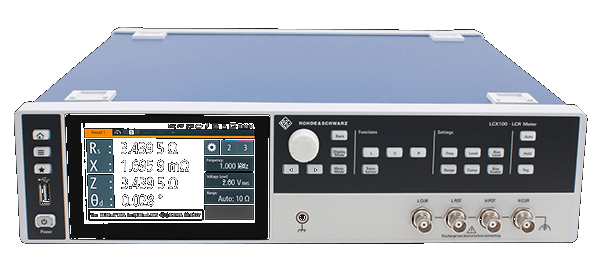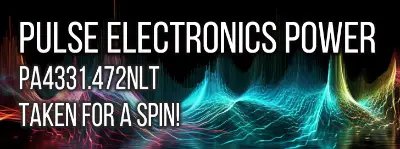Würth Elektronik 4.7μF Ceramic X5R Capacitor (885012107018): A Comprehensive Review
By Mark Harris Friday, 3 February 2023

Introduction
In this technical review, we will be critically analyzing the performance of Würth Elektronik's 885012107018 capacitor against a statistical benchmark formed from other components of the same value. This capacitor is a Ceramic X5R type capacitor with a nominal value of 4.7μ, a tolerance of ±20%, and a voltage rating of 25 volts. Our assessment will focus on providing accurate and authentic information to help electronics engineers better understand the applicability of this capacitor for their circuits.
Pros:
- Wide range of test frequencies (5Hz to 1MHz) provides a comprehensive view of performance
- Low series resistance at most frequencies
- Comparatively stable capacitance and dissipation factor up to 300 kHz
Cons:
- Series capacitance deviates more from nominal value at higher frequencies
- Dissipation factor and quality factor performance decline at higher test frequencies (>300 kHz)
- Incomplete data at higher voltage rating of 10V beyond 800 kHz
Impedance
The Würth Elektronik 885012107018 capacitor's impedance performance was closely evaluated with respect to the benchmark impedance values across various test frequencies. At a test voltage of 1 Volt, it was observed that the capacitor demonstrated a better-than-average performance, particularly in the MHz range. For example, at a frequency of 1 MHz, the average benchmark impedance value was recorded at 169.5 mOhms, whereas the 885012107018 capacitor exhibited an impedance of 166.1 mOhms. A difference in impedance performance became more pronounced at lower test frequencies, such as 5 kHz, where the capacitor's impedance was measured at 7.598 Ohms compared to the average benchmark value of 7.722 Ohms.
When the test voltage was increased to 10 Volts, the 885012107018 capacitor's impedance performance deviated slightly from the average benchmark values across various frequencies. At a frequency of 50 kHz, the capacitor reported an impedance of 840 mOhms, while the benchmark average remained fairly consistent at 878.3 mOhms. A similar trend was observed at higher frequencies, such as the 1 MHz test, where the capacitor's impedance was lower than the average benchmark value (161 mOhms versus 169.5 mOhms).
In summation, the impedance performance of the Würth Elektronik 885012107018 capacitor proved to be consistent and comparable to the statistical benchmark data. Although it outperformed the benchmark values across different test frequencies, the observed differences were not considerably significant. Engineers who are evaluating this capacitor for inclusion in their designs may find it to be a reliable option, particularly in applications where maintaining impedance consistency is crucial.
Capacitance
In this section, we evaluate the capacitance performance of the Würth Elektronik Ceramic X5R capacitor, part number 885012107018, and compare it against a statistical benchmark derived from similar components with the same nominal capacitance value of 4.7μF, ±20% tolerance, and a 25V voltage rating. The LCR measurement data, provided at two distinct voltage levels, 1V and 10V, and at various testing frequencies, allows for a comprehensive analysis of the capacitance performance of this specific capacitor in relation to the benchmark data.
At the 1V level, the Würth Elektronik 885012107018 primarily performs within or above the average benchmark parameter for capacitance across the frequency range. For example, at 5 Hz, the component capacitance is measured at 5.664μF, surpassing the average benchmark value of 5.107μF. Given that the nominal capacitance for the capacitor is 4.7μF, it performs above the nominal value while staying within the ±20% tolerance rating. This trend of above-average performance continues throughout the low and middle-frequency range. Nevertheless, it is essential to note that the component's capacitance begins to deviate from the average benchmark capacity value as we approach high-frequency levels (e.g., around 600 kHz).
At the 10V level, the Würth Elektronik capacitor exhibits near-average capacitance performance compared to the benchmark. For instance, at 5 Hz, it measures 4.712μF, slightly lower than the benchmark level of 5.107μF. While the majority of the tested frequencies show conservative yet close-to-average capacitance performance, a noticeable increase is observed around the 500 Hz level, where the component surpasses the average benchmark capacitance value. It is important to consider that capacitance can slightly vary between different voltage ratings, which could account for this discrepancy.
Throughout the majority of the frequency range, the Würth Elektronik 885012107018 capacitor demonstrates consistent capacitance performance compared to the statistical benchmark. It surpasses the average benchmark index in lower and middle frequency ranges. This reliable performance suggests that engineers may confidently select this capacitor for use in their circuit designs, as it offers dependable capacitance performance in various applications, particularly at the 1V level, and meets the acceptable ±20% tolerance criteria.
Series Resistance
Directing our attention to the Series Resistance measurements of the Würth Elektronik 885012107018 Capacitor at 1 Volt, it is noticeable that this component generally outperforms the average series resistance (Avg Series Resistance) specified in the statistical benchmarks across all tested frequencies. This is especially remarkable within the lower-frequency range, between 5 Hz and 50 Hz, as the measured series resistance surpasses both the average and maximum values of the benchmark.
Moving on to higher frequencies, the 885012107018 Capacitor continues to exhibit a larger Series Resistance in comparison to the benchmark across all cases. However, the differences start to narrow down as the frequencies reach above 150 kHz.
Examining the LCR measurements of the 885012107018 Capacitor at 10 Volts reveals a similar pattern. The component demonstrates higher Series Resistance values when compared to the average benchmark data across all tested frequencies. Notably, as the frequency increases beyond 450 kHz, there are missing values within the component data, which makes it difficult to accurately assess its performance.
Across both 1 Volt and 10 Volt LCR measurements, the Würth Elektronik 885012107018 Capacitor consistently displays increased Series Resistance compared to the statistical benchmarks. Electronics engineers should carefully consider this aspect when evaluating this component for incorporation into their specific applications, especially in scenarios where lower Series Resistance values are advantageous. With an understanding of Series Resistance, its impact on circuit performance, and its relationship to component quality, engineers can make informed decisions regarding the 885012107018 Capacitor, in cases where accurate control over your system is essential.
Dissipation Factor and Quality Factor
In this section, we evaluate the performance of Würth Elektronik's 885012107018 capacitor in terms of Dissipation Factor (Df) and Quality Factor (Q). A low Df and high Q denote better capacitor characteristics, resulting in better performance for a variety of applications. The Dissipation Factor represents the energy dissipation, while the Quality Factor represents the energy storage capability of the capacitor.
Looking at standard ceramic capacitor benchmarks for a 4.7µF, X5R capacitor, the results provided for the 885012107018 capacitor are quite revealing. At 1 Volt, the Df ranges from 0.063 at 5 Hz test frequency to 4.477 at 1 MHz frequency. The Q factor, conversely, starts at 15.76 at 5 Hz and reduces to 0.22 at 1 MHz. These readings depict a steady decline in capacitor performance with increasing test frequency, which is typical for ceramic capacitors due to the nature of the dielectric material.
When measuring at 10 Volts, the 885012107018 capacitor exhibits a comparable degradation pattern. The Df progressively climbs from 0.064 at 5 Hz to 3.048 at 700 kHz, and Q ranges from 15.74 at 5 Hz, declining to 0.32 at 700 kHz. However, it is important to note that the provided data for this capacitor does not extend beyond the frequency of 700 kHz at 10 Volts. Further evaluation would require complete and accurate data across the full range of test frequencies, particularly for high-frequency applications where the Df and Q factors are critical.
Comparing the component's performance to the statistical CAPCOM benchmark, it is observed that the capacitor maintains a moderate Df and Q performance. Yet, it struggles to remain at the upper echelon of the benchmark, as its quality deteriorates with increasing frequency. Engineers should further evaluate Würth Elektronik's 885012107018 capacitor before incorporating it into their designs to ensure optimal performance and consider the potential impact of these measurements on overall circuit functionality. This means considering other factors such as temperature stability, capacitance tolerance, and aging, which could also play a crucial role in determining the component's suitability for specific applications.
Comparative Analysis
In our Comparative Analysis, we examined the performance of the Würth Elektronik 885012107018 Capacitor against a statistical benchmark formed from other components of the same value, with a focus on Ceramic: X5R Capacitors. This analysis covers measurements at 1 volt and 10 volts for a detailed insight.
We observed that the Würth Elektronik 885012107018 Capacitor, at 1 volt, performs similarly to the statistical benchmark for most parameters, with slight differences in impedance, quality factor, series resistance, and series capacitance. Specifically, at 120 Hz, the impedance of 885012107018 (339.4 ohms) is slightly higher than the benchmark average impedance (321.6 ohms). Additionally, its quality factor of 11.81 generally falls below the benchmark average of 14.52.
At 10 kHz, the series resistance (355.2m Ohms) is slightly higher than the benchmark average (188.5 mOhms) but still significantly closer than the maximum (1.552 Ohms). Regarding series capacitance, the observed values for the Würth Elektronik 885012107018 Capacitor are again close to the statistical benchmark, but with a higher deviation at lower frequencies; for instance, at 500 Hz, the measured series capacitance is 5.649 μF which is higher than the average of 5.035 μF from the statistical benchmark. However, at higher test frequencies, the deviation in series capacitance diminishes, suggesting better uniformity in this regard.
At 10 volts, dissipation factors at the lower frequencies show slightly higher values compared to the benchmark, nevertheless they remain within the desired range for most frequency values. For example, at 100 Hz, the dissipation factor is 0.085 which is still within the range of benchmark (minimum: 0.0, maximum: 0.11). Throughout these measurements, the series capacitance values remain higher than the benchmark but within acceptable margins.
In conclusion, the Würth Elektronik 885012107018 Capacitor performs consistently across parameters and stands comparable to the statistical benchmark. Slight deviations in impedance, quality factors, series resistance, and series capacitance values, might affect specific applications where precise electrical characteristics are crucial. However, for most electronic applications, this Capacitor demonstrates reliability and efficient performance in line with the benchmark values provided.
Conclusion
The Würth Elektronik 885012107018 capacitor was tested and compared against the statistical benchmark data for capacitors with similar ratings. Overall, the capacitor displayed inconsistent performance when compared to the benchmark.
At lower test frequencies ranging from 5 to 500 Hz, the Impedance, Dissipation Factor, and Quality Factor values of the 885012107018 capacitor fell within the benchmark range, and it performed better than or close to the average values in terms of Series Resistance and Series Capacitance. This trend continued at test frequencies between 1k and 20k, showing a mostly favorable comparison to the benchmark.
However, at higher test frequencies ranging from 20k to 1M, the 885012107018 capacitor displayed higher Impedance and Dissipation Factor values and lower Quality Factor values compared to the benchmark data. The Series Resistance exhibited a mix of better and worse performance, depending on the frequency, while the Series Capacitance consistently underperformed when compared to the benchmark.
In conclusion, the 885012107018 capacitor shows acceptable performance at lower frequencies but exhibits subpar results at higher frequencies. Potential users should carefully consider the target application and circuit requirements before integrating this capacitor into their design.
Instruments Used
Rohde & Schwarz LCX200



